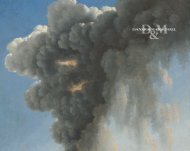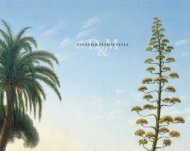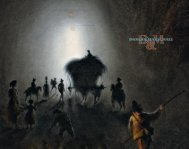Catalogue 2010 - daxer & marschall
Catalogue 2010 - daxer & marschall
Catalogue 2010 - daxer & marschall
You also want an ePaper? Increase the reach of your titles
YUMPU automatically turns print PDFs into web optimized ePapers that Google loves.
TEODORO DuCLèRE<br />
The Archbishop’s Palace in Palermo<br />
Teodoro Duclère<br />
(1812 - Naples - 1869)<br />
The Archbishop’s Palace in Palermo<br />
Oil on canvas<br />
Signed lower right T. Duclère / …<br />
Inscribed on the stretcher Palais<br />
Archiepiscopal de Palermo<br />
40.5 x 30 cm<br />
Provenance:<br />
Private collection, Germany<br />
20<br />
The city of Naples was an important stop on the Grand Tour from the eighteenth century onwards, attracting<br />
artists like Joseph Wright of Derby, Jakob Philipp Hackert and Claude-Joseph Vernet. In the 1820s, Naples<br />
saw a number of leading artists visit the city: Johan Christian Dahl in 1820-1, Franz Catel in 1824, Carl Gustav<br />
Carus (see p.32 & 34 of the present catalogue) and Jean-Baptiste-Camille Corot in 1828. J. M. W. Turner was<br />
in Naples on his first visit to Italy in 1819. Later, in 1828, his exhibition in Rome was to have a ground-breaking<br />
influence on artistic life in Italy.<br />
It was the Dutch painter Anton Sminck van Pitloo (1790-1837) who introduced plein-air painting to the city.<br />
He had settled permanently in Naples in 1816. 1 From his pioneering work the School of Posillipo – dedicated<br />
to the revival of the eighteenth-century veduta tradition – was to develop. The Italian historian Pasquale<br />
Villari, writing in 1855, describes its development: The splendid climate and magnificent scenery surrounding Naples,<br />
together with the numerous foreigners who were always after a drawing or painting as a memento, had spurred on a number<br />
of painters. They were referred to by the artists of the Accademia as the School of Posillipo, the place where they resided to be<br />
near their foreign clients. 2 Pitloo’s studio was a magnet for young artists, attracting figures like Achille Vianelli,<br />
Giacinto Gigante, Gabriele Smargiassi and Teodoro Duclère.<br />
Duclère was born in Naples on 24 May 1812 to French parents. He studied under Pitloo at the<br />
Real Istituto di Belle Arti some time between 1824 and 1831. He was a good friend of Pitloo and married<br />
his daughter Sofia in 1838. Duclère’s major patrons were the Tsar of Russia, the Russian Ambassador to<br />
Rome, and in Naples, the Duca di San Teodoro and the Meuricoffre family. He took up a post as professor of<br />
landscape painting at the Accademia di Belle Arti in Naples in April 1861. Around this time he was giving the<br />
noted Sorrento collector, Duca Pompeo Correale, instruction in painting. 3<br />
Duclère visited Sicily frequently from 1831 onwards. The present painting, depicting a view of the<br />
historic Archbishop’s Palace in Palermo, was executed on one of these visits. The Palace was built in 1460 and<br />
is the seat of the Archbishops of Palermo to this day. It stands on the square opposite Palermo Cathedral. In<br />
the present painting the architectural modifications the Palace had undergone over the centuries are very<br />
precisely depicted. The late-Gothic triforium and the marble balcony dating from 1587 and designed by<br />
Vincenzo Gagini (1527-95) are shown in minute detail. Towards the centre of the painting is a pedestal with<br />
the statue of Pope Agatho, the patron saint of Palermo. By a balustrade at the foot of the pedestal, a cluster<br />
of women, children and men in Sicilian costume 4 are depicted chatting and going about their business. The<br />
Palace wall serves as a backdrop in front of which the black-robed figures of priests gather before a cardinal.<br />
1. See Marina Causa Picone and Stefano Causa (eds.), Pitloo. Luci e colori del paesaggio napoletano, exhib. cat., Naples, Museo Pignatelli,<br />
2004, pp. 40-1.<br />
2. 19th-century landscape painting in Naples. Giacinto Gigante e la Scuola di Posillipo, exhib. cat., Valletta, National Museum of Archaeology,<br />
Naples 2000, pp. 14-5.<br />
3. See Renato Ruotolo, ‘Note biografiche su Teodoro Duclère e qualche appunto sulla famiglia Pitloo’, in Francesco Abbate (ed.),<br />
Percorsi di conoscenza e tutela. Studi in onore di Michele d’Elia, Naples 2008, pp. 487-8 and pp. 491-2. Pompeo Correale (1829-1900) and<br />
his brother donated their extensive art collection to the Museo Correale in Sorrento. Duclère is well-represented in the collection.<br />
4. Duclère had a strong interest in local costume. Between 1857 and 1866 he worked with Gigante, Filippo Palizzi and Saverio Altamura<br />
on illustrations for Francesco de Bourcard’s costume book Usi e costumi di napoli e contorni.






